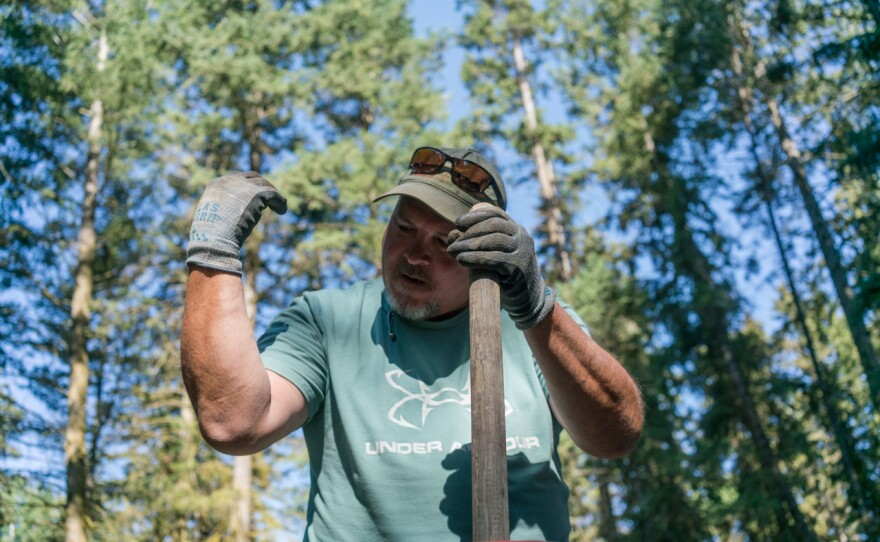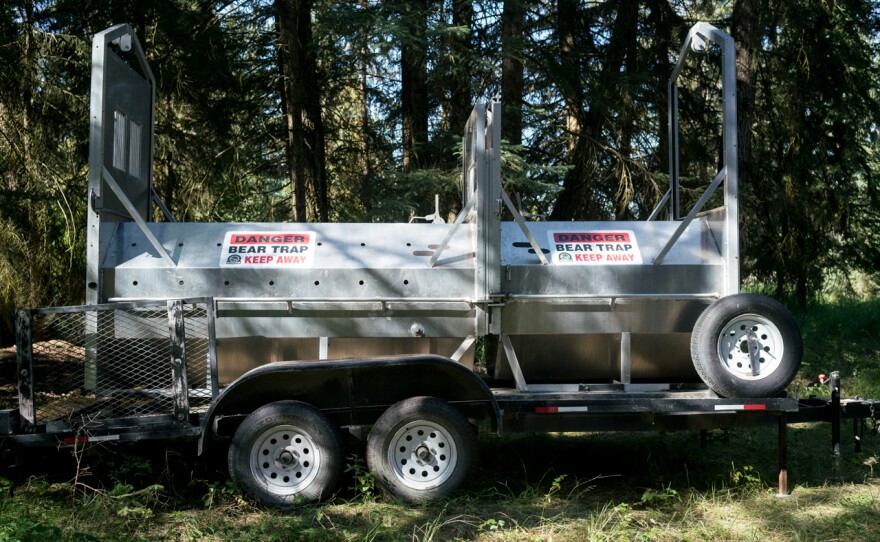Corrected 08/02/18, 6 p.m.
Grizzly bears in northern Montana are being killed this year at a rate far outpacing what’s typically seen.
On average, 25 grizzlies are removed from the population each year in the Northern Continental Divide Ecosystem. So far this year that number is already at 27.
Stacy Courville, a wildlife biologist for the Confederated Salish and Kootenai Tribes, says the biggest cause of the spike is cars.
"Over 18 years, we average three grizzly deaths by automobile," Courville says.
When Courville says “deaths,” he means grizzly bears taken out of the population - whether physically killed, or taken elsewhere. This year, 9 bears have died from vehicle collisions, and four more cubs have been orphaned and removed from the population. Data from Montana Fish, Wildlife, and Parks says that’s four times the annual average, and the highest number of removals from vehicle collisions ever recorded.
*Correction: In our July 27 version of this story, Montana FWP initially communicated that 12 grizzly bears had been directly killed by vehicles in the NCDE. After our story was published, they clarified that as of August 2, nine bears had been killed by cars, and an additional four had been orphaned and removed from the population due to vehicle collisions. Orphaned bears taken to zoos or research facilities, and all bears removed from the NCDE are still considered “mortalities,” since they’re no longer members of the population. The total number of bears removed from the population is 27
On July 28, a mother and two cubs were hit and killed crossing an area of Highway 93 south of Ronan with limited structures available for safe wildlife crossing. An additional cub was orphaned. Courville tracks bears in the area.
He says it's daunting, "for people just to cross 93. But for these bears trying to cross four lanes of traffic ..."
Courville says more bears than ever are crossing this stretch of road as their range expands farther west.
About a thousand bears live in the Northern Continental Divide Ecosystem, or NCDE. It’s the largest grizzly population in the lower 48. The NCDE is made up of about 8 million acres in Montana that encompass Glacier National Park, along with several wilderness areas and national forests.

Montana FWP spokesman Dillon Tabish says the population still has plenty of bears to flourish, so the rise in mortality isn’t particularly worrisome. At least not yet.
"It’s if these trends become trends, and they continue to happen and continue to increase, then it becomes alarming," Tabish says. "It’s really hard to judge these types of situations on a one-by-one basis, if that makes sense."
But bear advocates aren’t so sure.
"In reading the newspaper every day, you start goin’, ‘geez, there’s another bear,'" says Keith Hammer, chair of Swan View Coalition, a group that advocates for grizzlies.
"And so it’s quite alarming when you get this kinda numbers, and especially when it’s this early in the year," Hammer says.
Late in the fall, there’s usually a boom in bear deaths. As bears prepare for hibernation, they load up on calories to get ready for winter. If there’s a drought or a bad berry crop, it can mean more bears venturing near homes. And more bears removed from the population because they’ve started seeing houses as a source of food
"It’s just a deadly downward spiral," Hammer says, "and that’s what we’re seeing."
Both Hammer and FWP’s Dillon Tabish say the high number of deaths this year is due to a pretty simple equation. First, there are more humans living in the area than ever before.
"And then also along with that, there are more grizzly bears now than there have been in many years," Tabish says.
More humans plus more bears equals more dead grizzlies. In the NCDE, the population is growing at about 2.3 percent a year. Bears are turning up where they haven’t been seen for decades, or in some cases ever.
There’s also about 100,000 people living in Flathead County alone. It’s one of the fastest growing counties in the state.
"You’ve got 100 times more people, growing at a faster population rate than the bears are. And that’s why you start seeing things like this number of bears dying by getting hit by cars on roads," says Keith Hammer from the Swan View Coalition.

"And it’s not just our resident population that’s growing, but we have these record-setting numbers in the millions and millions of visitors coming to Glacier Park and the Flathead National Forest and Flathead Lake and other areas," Hammer says.
It’s peak tourist season right now, and Glacier saw more than 3 million visits last year. Four years in a row, the park’s had its highest number of visits ever.
It’s driving millions of dollars into the Montana economy, but also driving people into bears. Montana FWP’s Dillon Tabish says, "our statistics show that there isn’t any real particular area that this is all happening at, it’s just along mostly major highway routes."
Earlier this year, the U.S. Fish and Wildlife Service said it will propose to delist the grizzly bear in the NCDE from protections under the Endangered Species Act in September.
Keith Hammer says with this possibility looming on the horizon, these numbers are especially frightening.
"It will unwind so fast it will make your head spin if they remove the Endangered Species Act protections from the grizzly bear," he says.
No matter what the bear’s status on the Endangered Species Act, biologists in the NCDE are hard at work trying to learn how to prevent these bear deaths. Biologists like Kari Eneas.
She’s a wildlife biologist for the CSKT, and she’s standing in the back of a pickup truck, stirring a curdling stew of severed deer legs in a big, red plastic bucket.
"Well, I’ve been tracking the stages of the bait barrel and there was one stage that I deemed sulphurous and I think this is … kind of got a hint of old shoe?"
Eneas is re-baiting a grizzly bear trap. She fishes a smelly roadkill leg out of the barrel and places it in a culvert trap; a metal cylinder that looks like an oversized meat smoker. Stinky sneaker to us, this odor signals a tasty treat to a grizzly.

Once we leave, Eneas hopes a bear will crawl in here to get its snack, and then the door will slam shut and trap the bear in the cylinder. Eneas and her coworkers will sedate the bear, slip a high-tech collar over its neck and let it go.
"With the collar data, we can get GPS locations," Eneas says.
This shows up as little dots on a map. With those dots, biologists like Eneas can see when and where bears are getting into trouble.
Eneas is also a graduate student at the University of Montana, and this is part of her research focusing on the interaction between bears and ranchers. She works mostly with people in the Mission Valley who keep animals like chickens or llamas.
"Bears have to learn to live with us, but we also have to learn to live with bears as well," she says.

So the data show when bears are spending a little too much time around these ranches. And it also helps get a sense of what’s happening on highways. There’s a whole hidden infrastructure that allows wildlife to safely cross the road
This morning, Eneas is driving around Mission Valley, near Flathead Lake.
"And a lot of times as drivers you don’t even notice that they are there, but there’s these large culverts. And if you look right out this window you’ll see this one briefly. And those are wildlife crossing structures. And what that does it allows wildlife to safely cross the highway underneath, and so they’re not trying to dart in between traffic," she says.
Between Missoula and Polson, there are about 40 underpasses and one overpass that allow wildlife to cross. But bears aren’t always using them, and what biologists are finding is striking.
"We’re seeing a lot more female bears going west across [Highway] 93, with cubs. And they’re not using crossing structures," says Stacy Courville, who works with Eneas.
Females are key to the species’ continued growth. And he says these problems aren’t easy ones to fix.
"The Tribe, I mean, we want bears. We’ve always wanted bears here," Courville says. "That’s why we do what we do. We respond to conflicts, and we put up electric fence around people’s stuff. Occasionally we have to move bears. But yeah, I don’t see this going away."
I ask him if he's optimistic that people and bears can co-exist and both populations can thrive in the same area.
"We’re doing it now," he says. "These bears are doing a pretty good job of living in and amongst us, and most of the people don’t even know it."
Their data shows that the animal is everywhere here, even when hidden among the trees and brush. So even when physical grizzlies aren’t around, Eneas sees bears everywhere.

Driving down Mine Singer Trail and towards the Mission Mountains she points out, "a mountain ... that kind of looks like a bear, a teddy bear on its back."
Eneas grew up just down the street. There are three tribes here, and she said grizzlies have a special significance to all of them.
"The grizzly bear is definitely an important species, an icon, for those cultures. And growing up in that background has carried on into my professional life," Eneas says.
For her, it’s worth it, smelly deer legs and all. To her, both bears and humans can thrive, together.
"They’re just so majestic, and when you see them out in their habitat, it’s just, it’s beautiful. It’s a moment to stop and watch. It’s just been so humbling to be able to be a part of this study that is hopefully promoting tolerance and co-existence with these bears."




